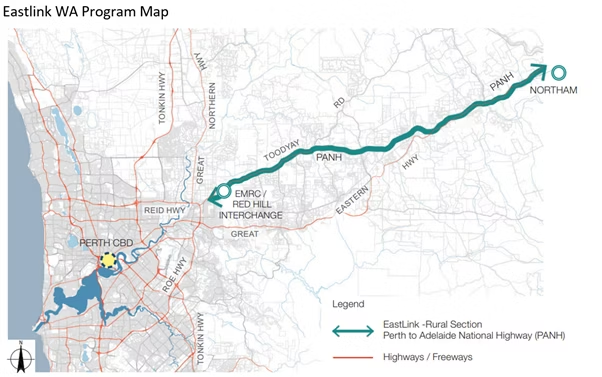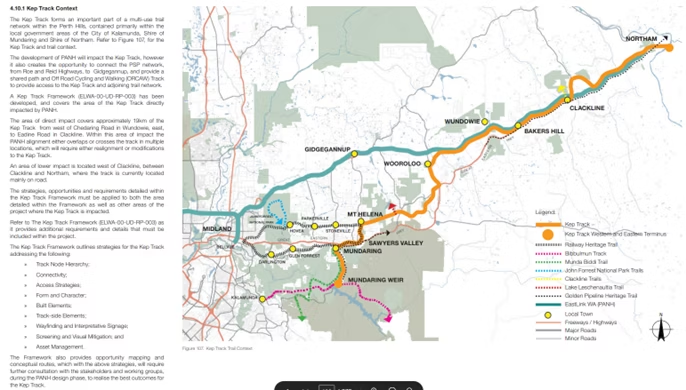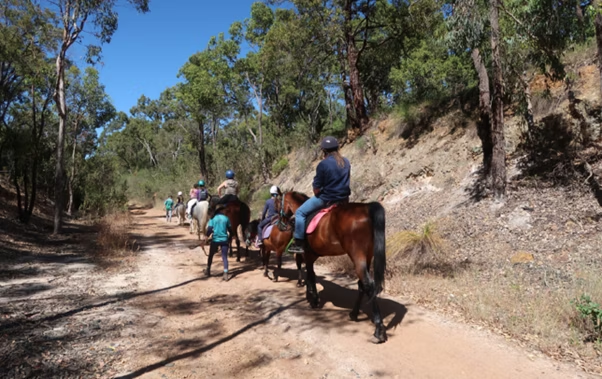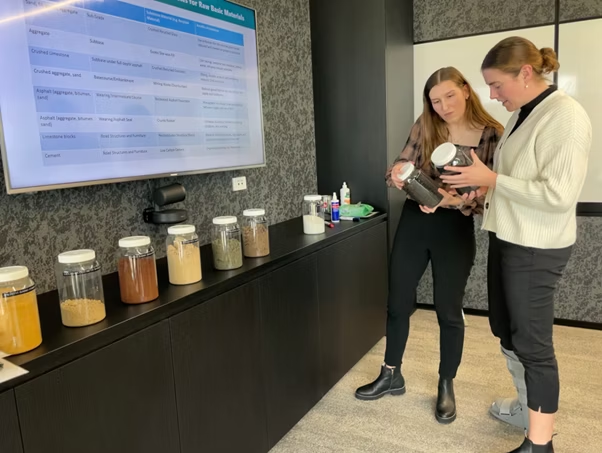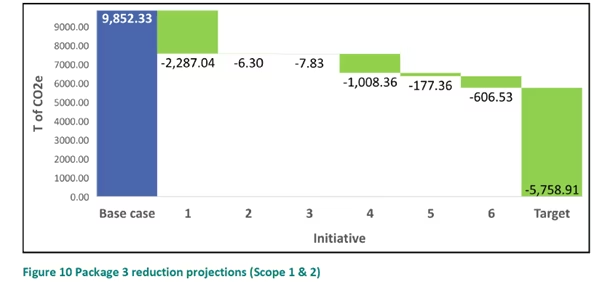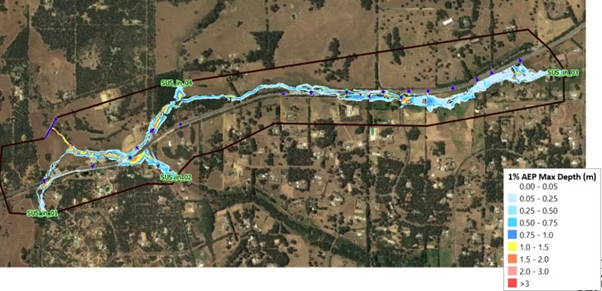Eastlink WA Program Rating – Outstanding Achievement
EastLink WA is one of Western Australia’s largest planning and development projects, bringing together over 40 years of planning activities to create a safer and more efficient route between Perth and Northam.
Extensive planning and development over two-and-half-years by the EastLink WA Integrated Project Team (IPT) has established a long-term design concept that caters to forecasted population growth and traffic volumes until 2051.
Eastlink WA achieved a ’Silver’ rating, exemplifying the enhanced social, environmental and sustainability outcomes achieved by the IPT’s approach to planning and development.
EastLink WA pioneered a Program approach to the IS Planning rating - focusing on long-term outcomes across five sustainability focus areas which embed sustainability throughout the project lifecycle.
The Program approach has delivered measurable benefits which showcase Main Roads WA’s commitment to sustainable infrastructure and provides a model now being used as a benchmark for one of Western Australia’s most significant infrastructure projects - Westport.
Describe WHAT you have done and HOW you have done it. Please provide a summary of your initiative, innovation, or approach.
EastLink WA is one of Main Roads Western Australia’s largest planning and development projects, bringing together over 40 years of planning activities to create a safer and more efficient route between Perth and Northam. Extensive planning and development over two-and-half-years has established a long-term design concept catering for forecasted population growth and traffic volumes until 2051.
The Outstanding Achievement Award submission focuses on the project’s outstanding achievement through adoption of initiatives and processes that focus on long-term outcomes, robust systems and processes, and development of key sustainability focus areas to guide project direction.
The project was undertaken by the EastLink WA Integrated Project Team (IPT) under a collaborative contract model between Main Roads Western Australia and a joint venture between GHD and BG&E.
The project adopted a Program approach to the ISC Rating – a first for an ISC Planning rating. The Program approach provides a more strategic and streamlined approach to large, long-term planning projects. It was adopted due to the project’s scale, and varied timeframes for delivery of packages.
The Program approach enabled flexibility to address local challenges and opportunities at package-level, yet cohesively delivered within a consistent program-wide strategy.
All Packages, and the overall Program achieved a ’Silver’ rating, exemplifying the enhanced social, environmental and sustainability outcomes achieved through the IPT’s approach to planning and development.
Having successfully developed the Program approach, EastLink WA’s rating provides a model which has now been adopted by other major planning projects including the WA State Government’s Westport project.
A systems-based approach was used to achieve buy-in across the IPT team, assess and focus on the project’s material issues and establish relationships with internal and external stakeholders that can carry forward to future phases.
EastLink WA’s sustainability approach encompasses several key elements:
- Developing a clear vision, objectives, and targets: Materiality assessment established five ‘Focus Areas’, which provide the central ‘story’ to communicate what sustainability means for this project. Developed and agreed by the broader project team, Main Roads specialists, and external stakeholders, they are available on the project website for our external stakeholders, and in posters for the project team. Focus Areas provide the structure for our objectives and targets, decision-making criteria, risk and opportunity assessment and guided resource allocation.
- Undertaking sustainability workshops at the outset, including multi-disciplinary teams.
- Developing a dedicated Sustainability Advisory Group, including external stakeholders and Main Roads’ specialists to capture and integrate a holistic perspective into design development.
- Establishing frameworks for consistency across all packages in the areas of: Decision-making, Aboriginal Engagement, Resource and Energy Efficiency and Urban and Landscape Design. For packages, localised application was achieved through action plans, design changes or engagement with specific stakeholder groups.
- Establishing processes to monitor initiatives and outcomes and embed sustainability: e.g. cross-discipline management meetings, steering committee meetings, monthly reports.
- Collaborating early with the Main Roads delivery team to enable handover of initiatives and documentation – provided to tenderers and forming the basis for the future Design and As Built ratings.
What were the OUTCOMES and how were those outcomes shared?
EastLink WA serves as a benchmark for future planning projects by Main Roads WA:
- First project to undertake a Program rating under the IS v2.0 Planning scheme.
- Delivered a long-term design concept that reflects the outcomes of robust decision making, both in the design itself, and in the changes to Planning Scheme boundaries.
- Established a framework and mechanisms for long-term engagement with the local custodians of the land – the Wadjuk, Yued and Ballardong people of the Noongar Nation – through an Elders Reference Group.
- Provided resource and energy efficiency opportunities and mandated targets which have informed delivery phase contract documents.
- Designed improvements for community assets such as the Kep Track trail.
Further detail relating to each project Focus Area is provided below.
Minimise energy, materials, and water footprint
A preliminary lifecycle assessment using the early reference design, identified priority materials and energy uses.
The IPT explored opportunities to reduce the footprint with input from Main Roads specialists and partner organisations, including East Metropolitan Regional Council and the Waste Management Association of WA.
Initiatives included in contract documents for the first delivery package included:
- Resource Efficiency Strategy and Resource Efficiency Action Plan including mandated reduction targets
- Provision for high-modulus asphalt (EME2) in pavement; and supplementary cementitious materials (SCMs) in non-structural elements
- Diesel reduction and renewable energy commitments
- Initiatives encouraging re-use of on-site/recycled materials
- Potential implementation of solar lighting on the principal shared path.
Environmental services and impacts
A preliminary Environmental Impact Assessment was completed to gain an understanding of the existing environment and potential project impacts. In addition to consideration of required offsets, the project’s Urban and Landscape Design Framework (ULDF) also identified potential sites for additional planting, for consideration in future phases, as well as enhancements for the Kep Track and other local recreational assets.
People and place
The project sought to maintain connectivity for communities and users, through design decisions, including:
- Linkage between the proposed Principal Shared Path and local shared path networks, including provision for a connecting path through an under-served section of the Perth Hills.
- Options assessments that improved outcomes for local amenity.
- Consideration for Aboriginal heritage places in the project’s UDLF.
- Establishing a dedicated Elders Reference Group. The Group has played a critical role in co-designing an Aboriginal Engagement Framework for the project. The framework, which has been handed over to Delivery, lays the groundwork for consultation in future project phases across five key pillars: Aboriginal heritage; Connecting with Country; Cultural recognition; Employment and training; and Business.
Requirements of the framework to be applied throughout Delivery to achieve better outcomes for the Aboriginal community include: Liaison with the established EastLink WA Elders Reference Group; Development of a cultural context document to guide the design and Development of a Cultural Competency Framework to build a strong project culture.
Design for the future
The project established a Sustainability Advisory Group with participants from three local governments, Department of Planning, Lands & Heritage, Department of Water and Environmental Regulation, Department of Communities, Eastern Metropolitan Regional Council and Office of Government Architect.
The Group informed the approach across all sustainability focus areas, providing valuable insights into resilience and climate change risks which were considered as part of the design. Registers captured risks and treatments for inclusion in contract documents.
The Group also informed the project’s approach for net zero transition and waste minimisation in line with State and local government policies.
Leveraging economic development
Initiatives required to be applied during Delivery for economic development include:
- Development of an Aboriginal Engagement and Participation Plan (AEPP) addressing the Framework’s five pillars, including sub-targets and KPIs.
- Engaging with Aboriginal businesses during request for proposal – analysis of market capacity, development of a project-specific Aboriginal businesses database, support for businesses to engage and bid and an Aboriginal Business Forum.
- Local spend targets based on contract value
- Initiatives to support the Swan Valley tourism industry.
Describe WHO benefited from your initiative, innovation, or approach?
A range of benefits at a project-wide and individual stakeholder level have been achieved as a result of EastLink WA’s integrated approach to sustainability.
The IPT benefited from the project’s adoption of a Program rating, resulting in the creation of an efficient, more strategic process for ratings, and has provided the foundation for improved sustainability outcomes. This knowledge will also be carried into future projects by the member organisations.
Main Roads’ Delivery Directorate has benefited from the completion of sustainability documentation for handover to tenderers for the first delivery package, ensuring sustainability priorities are considered and incorporated appropriately by tenderers.
The development of a program-level Resource Efficiency Strategy and Aboriginal Engagement Strategy will also provide a streamlined and consistent approach, which will benefit the custodians of future project phases.
Local community and environmental benefits have been achieved through stakeholder consultation and environmental surveys. Insights and data gleaned have informed decision-making on the project, resulting in positive social and environmental outcomes.
Knowledge sharing activities have had broader benefits for the wider industry; through presentations and symposiums, the IPT has shared experience embedding sustainability in decision-making and the benefits of the program planning rating approach.
Benefits can als0 be categorised by the project’s sustainability focus areas, as summarised below.
Minimise energy, materials, and water footprint:
Identifying and working with partner organisations, including East Metropolitan Regional Council and Waste Management Association of WA, has enabled mutually beneficial initiatives to be captured.
Environmental services and impacts:
The project’s Urban and Landscape Design Framework identified potential sites for additional planting for consideration in future phases, with the benefit of improving environmental values in the area.
People and place:
Local communities, cyclists and other road users will benefit from the consideration of connectivity and amenity in the design. Improved connections for users of the Kep Track trail, with a new link from this track to the project’s PSP.
Leveraging economic development:
The Aboriginal Engagement Framework will enable construction contractors for package one to develop an AEPP for the project to maximise Aboriginal employment and business opportunities during the construction phase. The Elders Reference Group has been established, stakeholders and partner organisations identified, and market briefings scheduled, to enable the contractor to embed and implement the principles of the Framework effectively upon contract award.
What LEGACY and UN SDG CONTRIBUTION was achieved?
EastLink WA represents the first planning and development project in Australia/ New Zealand to undertake a Program rating under the ISv2.0 Planning scheme. The project encompasses three work packages, all of which have been verified with a ‘Silver’ Planning rating, along with an overall Program Silver Planning rating.
The project is of significant scale and has set the benchmark for future planning and development projects on how to embed sustainability considerations into project design. This is exemplified by the adoption of a Program Planning rating by the Westport project, and the knowledge sharing between Main Roads and Westport. Knowledge sharing has taken the form of ongoing fortnightly meetings during 2023 and 2024 which have allowed discussion of the high-level strategic approach, as well as specific options for individual credits.
The adoption of a whole-of-project program approach has seen long-term benefits in several key areas. Enhanced stakeholder engagement and collaboration facilitated the formation of partnerships focused on resource efficiency, Aboriginal engagement and resilience.
Delivery of EastLink WA will likely occur as a number of packages as funding becomes available in future budgets. Long-term outcomes will be supported by the many frameworks developed, including the Aboriginal Engagement Framework, Urban and Landscape Design Framework, Resource Efficiency Strategy and Net Zero Project Transition Plan. Importantly, these frameworks provide a roadmap for achieving specific technical elements and also set out the partnerships established during the project’s 3 year timeframe so these can be revisited and the approaches updated as required.
Priority UN Sustainability Development Goals (SDG’s) identified for the project align to the project’s sustainability focus areas as follows:
1) Minimise energy, materials and water footprint of infrastructure – SDG6; SDG7; SDG8 and SDG15
Strategies, opportunities and partnerships were captured in the Resource Efficiency Plan (for materials and water) and the Net Zero Project Transition Plan (for energy). Opportunities developed during planning were progressed in delivery for package 1, enabling Main Roads to set firm targets of at least 10% reduction in energy, water and materials footprint, along with requiring commitments to encourage industry to develop solutions to further stretch beyond business as usual. Remaining packages are unfunded, so instead of setting targets that may become out dated, the Plans provide a roadmap for the technologies that are becoming available for Main Roads projects over future time horizons.
2) Environmental services and impacts – SDG 6; SDG11; SDG15
The rural sections of the road are located in areas of native vegetation as well as farmland. Road alignment adjustments, including at Susannah Brook and Bakers Hill, as well as the selection of the road corridor and access road locations has minimised clearing through the design, and new planning controls.
3) People and place – SDG3; SDG11; SDG16
The project will improve places that our stakeholders value. Incorporation of local knowledge from the community, local businesses and technical specialists into our project design embed enhanced built environment outcomes. Key examples include the Kep Track enhancements and local amenity criteria in decision-making.
4) Design for the future – SDG9; SDG11; SDG13
Once constructed, infrastructure is in place for future generations. Recognising this, the project team has considered improvements in resilience for communities to climate change, natural hazards and other shocks.
5) Leveraging Economic Development – SDG8
Jobs and business opportunities created through infrastructure projects can grow market capability and benefit the regional economy. The Aboriginal Engagement Framework is in place and provides the basis for future phases to enable Aboriginal participation. The first package to move into delivery phase (Reid Highway Upgrades) includes local spend targets based on contract value, and initiatives to support the Swan Valley tourism industry.


